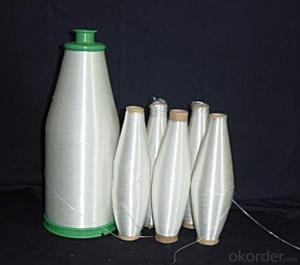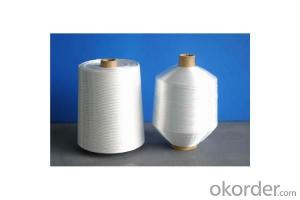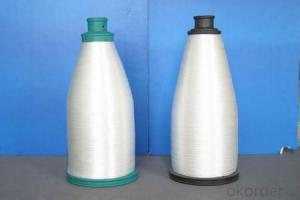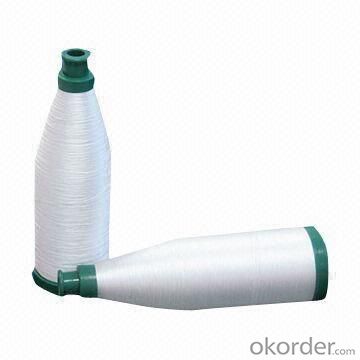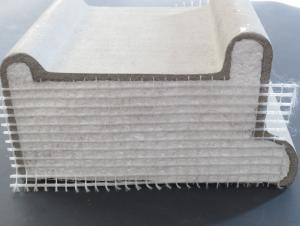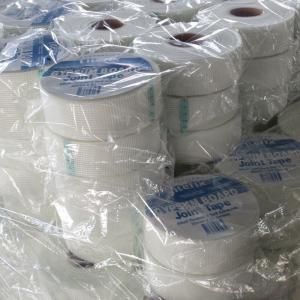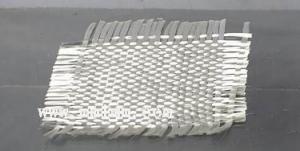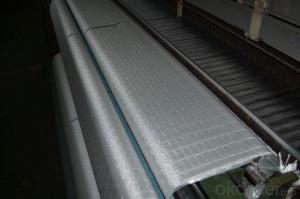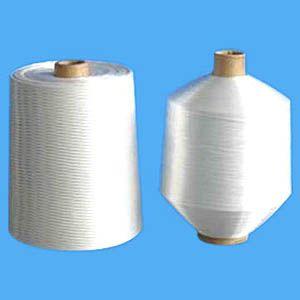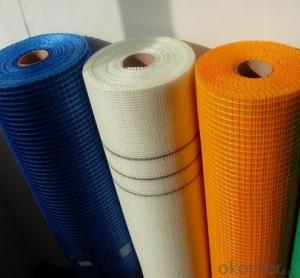Fiberglass Fabrics - C/E Fiber Glass Yarns with Best Price and Quality
- Loading Port:
- China Main Port
- Payment Terms:
- TT or LC
- Min Order Qty:
- 2000kg kg
- Supply Capability:
- -
OKorder Service Pledge
OKorder Financial Service
You Might Also Like
Description:
C or E textile glass a kind of additional twisting and plying yam. With the characteristics of high strength, corrosion resistance, heat resistance and high moisture absorption, no alkali yam has high electric insulation, so it used to produce weaved wires and cables’ wrap cladding, protection sleeve, train of mine, insulation materials of electric machinery, every yam of woven cloth and other industrial yam. It can also supply big and little paper cube and other cube yams with different shapes and different roll weight.
Product Features:
● Good Dispersibility.
● Less fuzzy.
● Density Even.
 Product Specifications:
Product Specifications:
Product Code | Tex | diameter (um) | Sizing. | breaking strength | Twist |
CC7.5-22-1/2 110S | 44 | 7.5 | paraffin | ≥15.5 | 110±10 |
EC9-33-1/2 65S | 66 | 9 | ≥24.1 | 65±5 | |
EC8-25-1/2 65S | 50 | 8 | ≥19.2 | 65±5 | |
CC9-33-1/2 65S | 33 | 9 | ≥20.6 | 65±5 | |
CC11-44-6/0 | 264 | 11 | ≥81.6 | ||
CC11-44-1/3 110S | 132 | 11 | silane | ≥40.8 | 28±3 |
EC9-68-1/0 28Z | 68 | 9 | ≥18.0 | 28±3 |
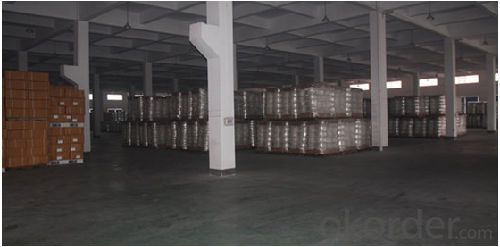
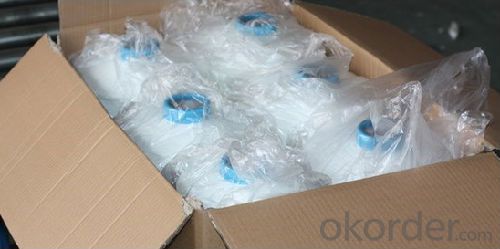
Storage:
Unless otherwise specified,It should be stored in a dry, cool and rain-proof area. It is recommended that the room temperature and humidity should be always maintained at 15℃~35℃ and 35%~65% respectively.
packaging:
with cartons
FAQ:
1.What is the delivery time ?
15days after receiving the deposit
2.Are you a trading company or factory.
We are factory,and we have more than 10 years of experience.
- Q: Can fiberglass fabric be used for heat-resistant gloves?
- Yes, fiberglass fabric can be used for heat-resistant gloves. Fiberglass has excellent thermal resistance properties, making it suitable for applications that require protection against high temperatures.
- Q: How do fiberglass fabrics perform in terms of thermal conductivity?
- Fiberglass fabrics possess a generally low thermal conductivity, thereby effectively preventing the transmission of heat. The distinctive makeup of fiberglass, comprising delicate glass fibers, establishes a barrier that restricts the flow of thermal energy. This attribute renders fiberglass fabrics appropriate for diverse applications necessitating thermal insulation. Whether employed in construction, automotive insulation, or even protective garments, fiberglass fabrics excel in diminishing heat transfer and upholding temperature stability. Moreover, their low thermal conductivity aids energy efficiency by minimizing heat loss or gain, ultimately resulting in reduced energy consumption and cost savings.
- Q: Can fiberglass fabric be used for conveyor belts?
- Yes, fiberglass fabric can be used for conveyor belts. It is a durable and flexible material that can withstand high temperatures, chemicals, and abrasive materials commonly found in conveyor belt applications. Additionally, it offers excellent dimensional stability and low elongation, making it suitable for various industries such as mining, agriculture, and manufacturing.
- Q: Can fiberglass fabric be laminated with other materials?
- Fiberglass fabric possesses the capability to be combined with other substances through lamination. Lamination entails the act of uniting two or more layers of material in order to produce a composite material that boasts heightened properties. Fiberglass fabric frequently functions as a reinforcing material within laminates, granting them strength and endurance. It is feasible to laminate fiberglass fabric with diverse materials, including resins, plastics, metals, and alternative fabrics, to generate composite structures that possess particular characteristics. The lamination process generally entails the application of an adhesive or resin layer onto the fiberglass fabric, followed by bonding it with the desired substance. This process allows for the creation of adaptable and customizable materials that can be employed across a broad range of industries, such as aerospace, automotive, construction, and marine.
- Q: Is fiberglass fabric resistant to chemicals used in water treatment?
- Yes, fiberglass fabric is generally resistant to chemicals used in water treatment. Fiberglass is known for its excellent chemical resistance and is often used in various industries, including water treatment facilities. It can withstand exposure to a wide range of chemicals, including chlorine, acids, alkalis, and other commonly used chemicals in water treatment processes. This chemical resistance makes fiberglass fabric a suitable choice for applications where it may come into contact with these chemicals, providing durability and longevity. However, it is important to note that the specific type and concentration of the chemicals used in water treatment should be considered when selecting the appropriate fiberglass fabric, as some chemicals may require additional protective measures.
- Q: What does 240 grams of fiberglass cloth mean?
- Fiberglass cloth is also commonly called fiberglass geotextile. A geosynthetic material widely used in civil engineering. It is mainly made of glass fiber and staple fiber, needle punched non-woven fabric composite geosynthetics.
- Q: What's the best form of roof waterproof?
- If it is inclined roof, with chimney or straight vent, it is recommended that the chimney around to focus on waterproof treatment. In addition to the use of ordinary cement base, do not use aluminum foil like asphalt, suggested above neutral weatherproof sealant coating, it can keep a long time waterproof! Personal experience.
- Q: Is fiberglass fabric resistant to chemicals in industrial settings?
- Yes, fiberglass fabric is generally resistant to chemicals in industrial settings. Its non-reactive nature and strong resistance to corrosion and degradation make it a suitable material for protecting against chemical exposure in various industrial applications.
- Q: How does the weave pattern affect the strength of fiberglass fabric?
- The weave pattern of fiberglass fabric plays a crucial role in determining its strength. The weave pattern refers to how the individual fiberglass strands are interlaced with each other during the manufacturing process. There are several common weave patterns used for fiberglass fabric, including plain weave, twill weave, and satin weave. The plain weave pattern is the simplest and most common. It consists of an over-under pattern where each strand alternates over and under the adjacent strands. This weave pattern provides good strength and stability in both the warp and weft directions, making it suitable for a wide range of applications. Twill weave pattern is characterized by a diagonal pattern formed by the interlacing of the strands. This pattern provides better drapability and flexibility compared to plain weave. Twill weave offers enhanced strength and durability, particularly in the direction of the diagonal weave. It is commonly used in applications that require better resistance against wear and tear. Satin weave pattern is the most complex and intricate. It involves a series of floating warp or weft strands that pass over several adjacent strands before interlacing again. Satin weave provides a smooth and lustrous surface, making it ideal for applications that require an aesthetic finish. However, it sacrifices some strength and stability compared to plain or twill weaves. In summary, the weave pattern of fiberglass fabric significantly affects its strength. While plain weave offers good overall strength, twill weave enhances durability and resistance to wear and tear. Satin weave sacrifices some strength for a smoother surface and improved aesthetics. The choice of weave pattern depends on the specific requirements of the application, balancing factors such as strength, flexibility, and appearance.
- Q: Can fiberglass fabric be used for insulation blankets?
- Yes, fiberglass fabric can be used for insulation blankets. Fiberglass fabric is known for its excellent thermal insulation properties, making it a popular choice for insulation applications. It is lightweight, flexible, and can be easily molded into the desired shape. Fiberglass fabric is also resistant to high temperatures, chemicals, and moisture, making it suitable for use in various industrial, commercial, and residential settings. Additionally, it is non-combustible and has a low thermal conductivity, allowing it to effectively trap heat and prevent energy loss. Therefore, fiberglass fabric is a suitable material for insulation blankets, providing thermal insulation and energy efficiency.
Send your message to us
Fiberglass Fabrics - C/E Fiber Glass Yarns with Best Price and Quality
- Loading Port:
- China Main Port
- Payment Terms:
- TT or LC
- Min Order Qty:
- 2000kg kg
- Supply Capability:
- -
OKorder Service Pledge
OKorder Financial Service
Similar products
Hot products
Hot Searches
Related keywords

